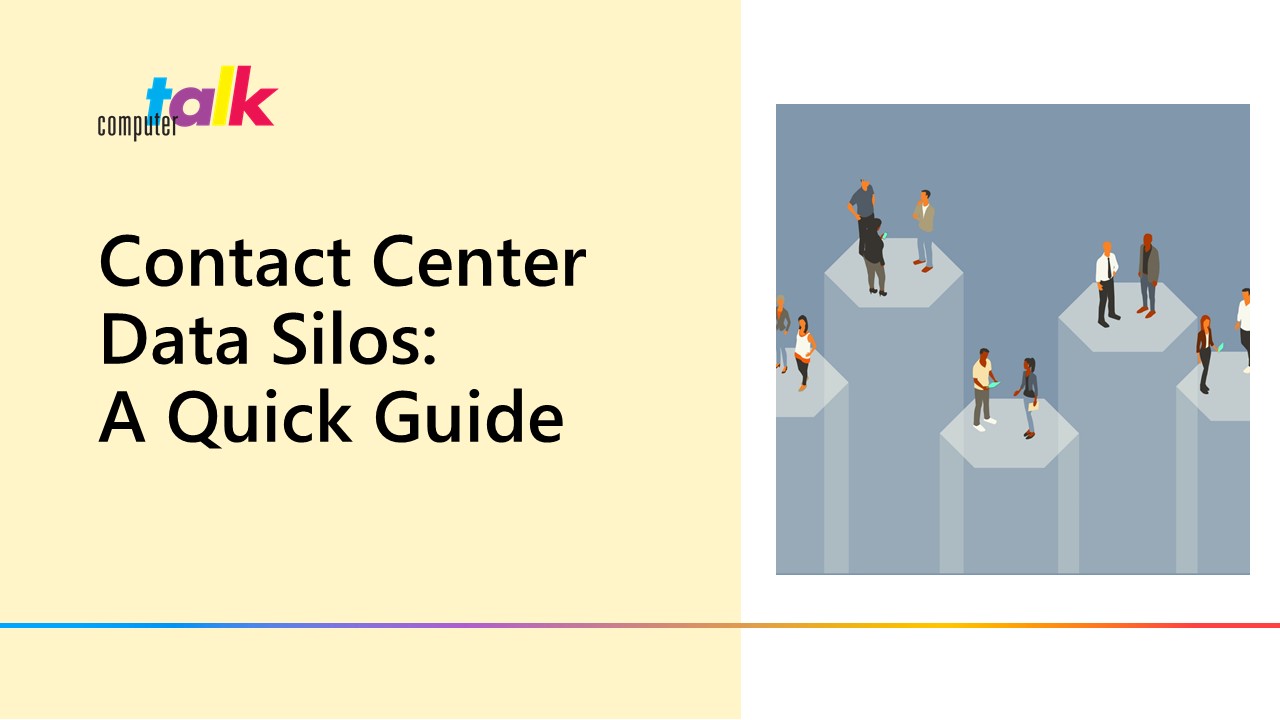Contact Center Data Silos: A Quick Guide
by Kent Mao | Published On December 4, 2023 | Last Updated December 14, 2023

Data silos are a well known issue in the contact center world, but new software solutions can help.
Whether you’re a small business or a large enterprise, data silos can pose a major problem for your contact center. If data cannot be accessed quickly and efficiently within your organization, you may be suffering from siloed data.
But what exactly are data silos and how can they be overcome? In this article, we’ll explain everything you need to know about data silos within contact centers.
What are Data Silos?
A data silo is a collection of information that is accessible by one department only and inaccessible to other parts of the company.
You can think of them as islands of data, which are isolated and cut off from other departments and teams.
When information isn’t shared across different teams within a company, that creates a data silo. Since large companies tend to have many different teams — often working in isolation from one another — data silos are a common problem.
What are Contact Center Data Silos?

When agents in a contact center interact with a customer, the data is usually stored somewhere for future use. However, the data is often grouped based on which method of communication was used — phone, email, live chat, social media, etc.
As a result, agents often need to juggle multiple systems when interacting with customers. In fact, a recent study by Forrester found that 84% of contact center leaders report their agents have between 4-10 different applications open during a typical customer interaction.
Companies may also rely on different tracking tools or software which are not fully integrated with each other. For example, phone calls may be logged in a CRM software while instant messages are stored on another platform.
Data can easily become siloed if there is no central database that tracks customer interactions across different platforms.
Why are Data Silos Bad for Businesses?
There are many reasons why contact center data silos are bad for the customer experience and for your overall business.
- Data silos prevent contact center agents from knowing the full customer story. In other words, the agent doesn’t have all the customer’s data and contact history in one place. This leads to slow-moving contact center agents who lack enough information to truly understand the customer’s needs and provide solutions to their problems.
- Data silos can lead to negative customer experiences. Without having all the data at their disposal, contact center agents are more likely to create a negative impression. For example, they may ask for information that they should already have or take a long time to track down the correct information. Negative customer experiences such as long wait times, multiple agent transfers and customers being asked to repeat themselves, are all problems that stem from data silos within a contact center.
- Data silos can increase costs and decrease productivity. Having data silos within your contact center leads to wasted time and money, which ultimately leads to increased business costs. They also create barriers between different teams, resulting in inefficiencies and bottlenecks. Breaking down data silos leads to better agent productivity and improves the operational efficiency of your contact center.
How to Identify Data Silos

In order to fix the problems associated with data silos, you must first be able to identify them. But do you know the signs of a data silo within a contact center?
Common signs
- Lack of data within a team or department, often requiring cross-functional communication to obtain
- Incomplete or outdated data within databases or records
- Teams are unable to access specific sets of data quickly or within a reasonable time
Often, these signs can go unnoticed, especially within large organizations where teams and departments operate independently.
However, one sure way to tell that your company is suffering from data silos is soaring IT costs related to data keeping and retrieval.
How to Fix Data Silos in Your Contact Center
Data silos are common within companies and they can happen for a variety of reasons. Ultimately, organizations must work to identify and resolve data silos in order to improve efficiency and business performance.
Here are a few steps that can help fix data silos within your contact center:
Invest in software that can integrate data from different systems
Many companies are still reliant on legacy systems that are outdated and have weak or non-existent integration capabilities. To overcome data silos, companies need to invest in modern software solutions that allow for quick transfers of data and the ability to cross-reference information when needed. One such solution is software that integrates all your data systems into one, also known as integration platform as a service (iPaaS). These solutions work by providing a centralized platform for managing and accessing cloud-based applications and data. Leading iPaaS providers include companies like Zapier, Workato and MuleSoft.
Choose an omnichannel contact center solution
Contact center solutions with omnichannel capabilities, such as ComputerTalk’s ice software, are designed to prevent data from being siloed. Omnichannel contact centers allow customers to interact with your business across a variety of channels: phone, email, live chat and more. Unlike legacy systems, ComputerTalk’s ice Contact Center solution integrates with leading CRM solutions, such as Salesforce and Microsoft Dynamics. Through these CRM integrations, customer data can be housed in one place, regardless of which channel the interaction took place on. This way, contact center agents can quickly and efficiently retrieve all of a customer’s information.
Leverage the power of AI tools
Generative AI is quickly becoming one of the most powerful tools within the contact center world. Not only can this technology improve the customer experience, but it also has the ability to enhance agent workflows and optimize daily tasks. For example, the right AI tools can sift through large quantities of data and intelligently surface the required information. AI tools can automate the process of gathering and storing data too. Finally, AI chatbots can ask questions and provide contextual insights to prepare a contact center agent before a live interaction. While AI applications are still very new in today’s contact centers, it is clear that data silos are one problem they can help solve.
Summary
Data silos are all too common in businesses today, and contact centers are one area where they can cause significant harm. If you are in charge of a contact center and are experiencing data roadblocks and inefficiencies, siloed data may be the cause.
Thankfully, modern contact center solutions have been designed to overcome data silos by leveraging CRM integrations and storing customer information in one central database.
If you are still using a legacy contact center platform with outdated data storage features, it might be time to consider an upgrade.
More from our blog
 Evolving customer expectations, combined with rising talent shortages in the contact center has led to a massive increase in the number of companies adopting AI-powered tools.
Evolving customer expectations, combined with rising talent shortages in the contact center has led to a massive increase in the number of companies adopting AI-powered tools.
 While asynchronous communication, such as email, has been around for decades, its relevance has grown significantly in today’s fast-paced, convenience-driven society.
While asynchronous communication, such as email, has been around for decades, its relevance has grown significantly in today’s fast-paced, convenience-driven society.
 Growing up in the Philippines, back when technology was still evolving, pursuing a career was limited to a few choices: becoming a Doctor, Nurse, Lawyer, Engineer, or Teacher. Growing up, I always knew that I wanted to pursue a career...
Growing up in the Philippines, back when technology was still evolving, pursuing a career was limited to a few choices: becoming a Doctor, Nurse, Lawyer, Engineer, or Teacher. Growing up, I always knew that I wanted to pursue a career...

